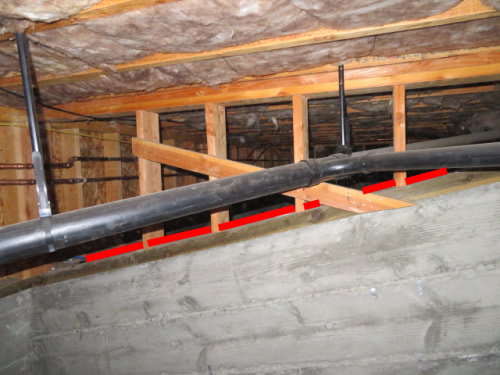I'm working on an existing house that has several continuous strip footings that are sloped. This means that the sill plate is also sloped, and the stud ends are cut at an angle so they can rest on this sloped sill. I'm not sure why they didn't step the footing, but slope it they did and now we have to deal with it. My question is whether there is any guidance for how these studs should be braced/blocked/etc. so that the bottom of each stud doesn't kick out like it seems prone to do. I searched the code, and online, but have come up empty which is why I'm asking all of you. Let me know your thoughts!
Navigation
Install the app
How to install the app on iOS
Follow along with the video below to see how to install our site as a web app on your home screen.
Note: This feature may not be available in some browsers.
More options
Style variation
-
Congratulations MintJulep on being selected by the Eng-Tips community for having the most helpful posts in the forums last week. Way to Go!
You are using an out of date browser. It may not display this or other websites correctly.
You should upgrade or use an alternative browser.
You should upgrade or use an alternative browser.
Studs on sloped foundation 2
- Thread starter palves
- Start date
- Status
- Not open for further replies.
- Thread starter
- #4
The studs bear on the sill, not the footing. I've also attached a picture of one of the conditions that actually does have a brace installed, but most other conditions don't. And the main thrust of my question is just to see if there is a code provisions addressing this situation.
If it were my house and I was really worried about it, maybe you could just run a SDS or Timberhex screw or something through the wide side toe of the stud into the sill plate from the downhill side if youre looking for an in-situ fix. I have no code refs, etc., to back that up but I'd feel fuzzier.
Or, if youre keen on doing it 'right' you could notch a flat spot into the sill plate and install new studs on the flat spots. Looks like a 3x sill. Plenty of meat left.
Or, if youre keen on doing it 'right' you could notch a flat spot into the sill plate and install new studs on the flat spots. Looks like a 3x sill. Plenty of meat left.
-
2
- #6
SlideRuleEra
Structural
I would block between the bottoms of the studs (shown in red) even if "code" does not require action:


Palves:
Didn’t the older bldg. codes have some discussion/provision for sloped ftgs. up to a curtain slope and then they had to be stepped? What was the rationale/logic there? We know that there is some friction component there, but the question is how much comfort does that give you as the EOR, either at the soil/ftg., conc. wall/sill pl., or the sill pl./stud end interface? That brace you show does help stabilize the whole wall section, expect there are only a few nails into the sill pl., so how much bracing? That brace does nothing for the left two studs, as regards their slope-cut lower ends on the sill pl., and a couple toenails doesn’t do much either. And, if you figure some sliding load component on that whole wall section, that one A.B., we can see, isn’t much either. Now, add in your EQ design considerations, and see how you like it.
You might take a 10-12” long 2x block, laying flat and nailed to the sill pl., with a plumb-cut end to mate with a stud. You could sheath that whole section of wall, but you might have to add a couple A.B’s. also.
Didn’t the older bldg. codes have some discussion/provision for sloped ftgs. up to a curtain slope and then they had to be stepped? What was the rationale/logic there? We know that there is some friction component there, but the question is how much comfort does that give you as the EOR, either at the soil/ftg., conc. wall/sill pl., or the sill pl./stud end interface? That brace you show does help stabilize the whole wall section, expect there are only a few nails into the sill pl., so how much bracing? That brace does nothing for the left two studs, as regards their slope-cut lower ends on the sill pl., and a couple toenails doesn’t do much either. And, if you figure some sliding load component on that whole wall section, that one A.B., we can see, isn’t much either. Now, add in your EQ design considerations, and see how you like it.
You might take a 10-12” long 2x block, laying flat and nailed to the sill pl., with a plumb-cut end to mate with a stud. You could sheath that whole section of wall, but you might have to add a couple A.B’s. also.
All I see is you now have a lateral component to your reaction to check out. As a carpenter, I would add the blocks as Slide suggests for 2 reasons. It is not hard to do and if you do not, someone will probably always question this. You have already reviewed it, but no one in the future would know that.
- Status
- Not open for further replies.
Similar threads
- Question
- Replies
- 6
- Views
- 10K
- Replies
- 14
- Views
- 7K
- Replies
- 3
- Views
- 1K
- Question
- Replies
- 17
- Views
- 16K
- Locked
- Question
- Replies
- 13
- Views
- 6K
